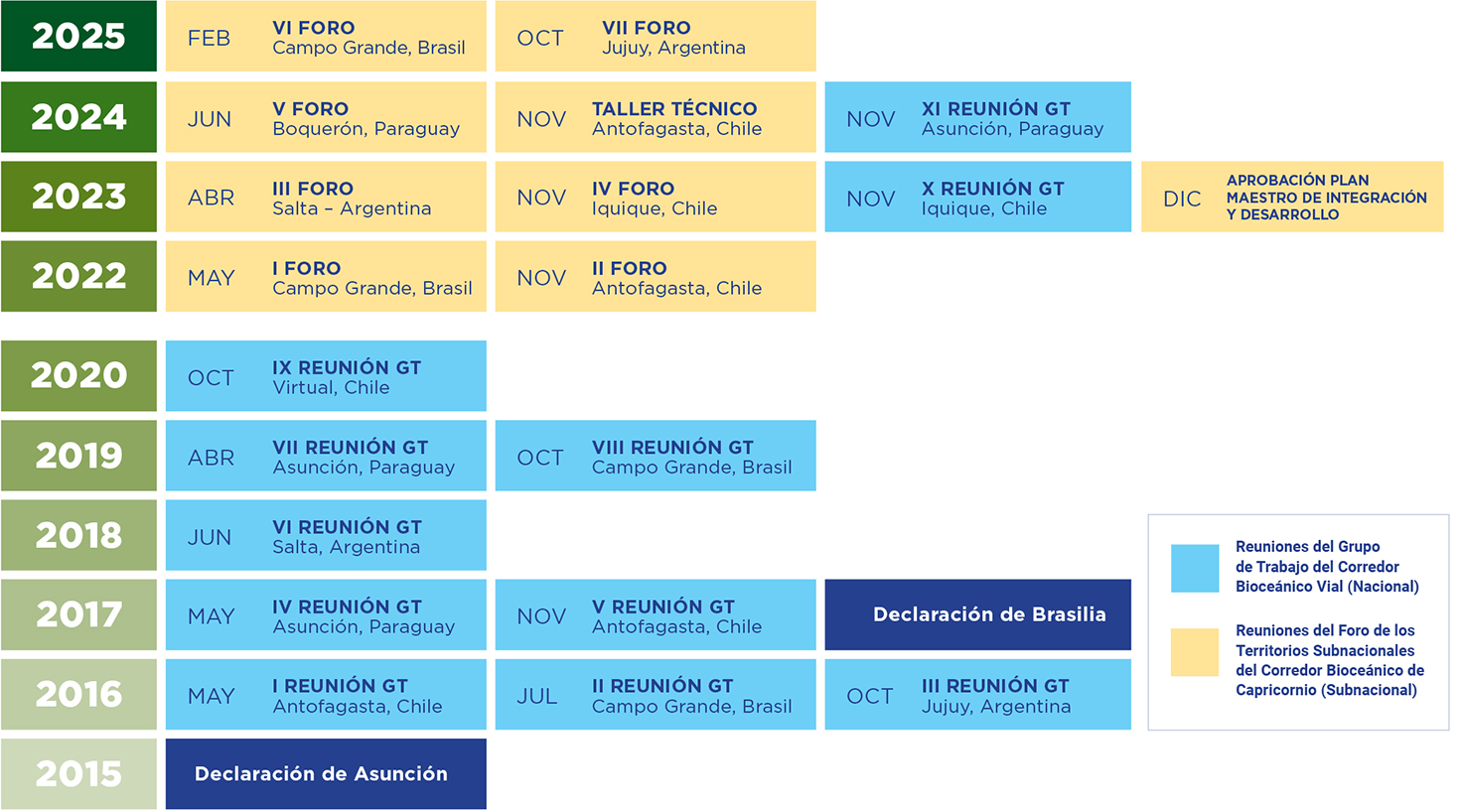History
The first antecedent of a Bioceanic Corridor in South America dates back, in fact, to over half a century ago: it is attributed to the Brazilian economist and politician Celso Furtado, who, starting in the 1960s, raised the challenge of connecting the Atlantic and Pacific Oceans through a network of infrastructure that would facilitate trade and economic integration among South American countries. Although distant, his vision laid the foundation for future initiatives of the Capricorn Bioceanic Corridor.
Also anchored in the 20th century, the creation of the Interregional Business Group of the South American Midwest (GEICOS) in the 1970s, and later the Integration Zone of the South American Midwest (ZICOSUR) in 1997, were other fundamental milestones in the relationship of the subnational states of Argentina, Brazil, Bolivia, Chile, and Paraguay.
The main objectives of both initiatives were to promote cross-border cooperation and economic integration in the region, including the development of infrastructure and the improvement of connectivity among these countries. Their integrative concept was crucial for the subsequent advancement of the Capricorn Bioceanic Corridor.
21st Century: Recent History
In August 2000, as part of the agenda of the First South American Summit in Brasilia, the Initiative for the Integration of Regional Infrastructure in South America (IIRSA) was created. This initiative focused on promoting the physical and economic integration of the South American region through infrastructure projects.
As a result of IIRSA meetings, in January 2009, during the third UNASUR Heads of State meeting in Quito, the South American Council of Infrastructure and Planning (COSIPLAN) was established, aiming to become the technical body of IIRSA. COSIPLAN’s main objective was to identify and prioritize projects that would improve connectivity and integration at the South American level, ensuring they were aligned with the sustainable development goals of the member countries.
One of the key studies carried out by IIRSA – COSIPLAN was the so-called Capricorn Axis, a bioceanic route that connects the port of Paranaguá on the Atlantic (State of Paraná, Brazil) with Antofagasta on the Pacific (Chile), crossing Argentina, Bolivia, and Paraguay.
In the last decade, the most significant antecedent was in 2015 with the signing of the “Asunción Declaration on Bioceanic Corridors,” subscribed by the presidents of Argentina, Brazil, Chile, and Paraguay, during the Mercosur summit in the Paraguayan capital. Since then, each country instructed its respective Ministry of Foreign Affairs to form a Quadripartite Working Group, integrating the areas of Infrastructure, Public Works, Transportation, and other related institutions, with the aim of promoting technical studies and formulating pertinent recommendations for the prompt realization of the Capricorn Bioceanic Corridor.
For almost a quinquennium after the 2015 Asunción Declaration, several meetings of the Quadripartite Group took place. Among these meetings, the Declaration of Brasília, held in the eponymous city in 2017 also within the framework of Mercosur, stands out, instructing the development of a Pilot Plan to follow up on the progress made in the various working groups.
Progress was halted by the global pandemic in 2020, and it was only at the end of that year that meetings resumed virtually. The Quadripartite Group’s meetings continue to be held to this day, on an annual basis.
The Forum Moment
Post-pandemic, the eight subnational states (departments, regions, provinces, or states, depending on the country) whose territories are crossed by the Corridor’s route and who are the main beneficiaries of its realization, formalized their intention to work together to promote progress.
For this, the Capricorn Bioceanic Corridor Integration Forum was formed, signed in the Campo Grande Declaration (Brazil) in May 2022, which is the body currently promoting the initiative.
Thus, both the Quadripartite Working Group (at the national level) and the Integration Forum (at the subnational level) are institutional dialogue instances that coexist for the realization of the Capricorn Bioceanic Corridor.
In May 2023, as a result of the III Forum held in Salta a month earlier, strategic and financial support was requested from the IDB (Inter-American Development Bank) to establish a Regional Public Good (RPG).
The request was approved in November of the same year, with the mandate to develop a Regional Master Plan for the Integration and Development of the Capricorn Bioceanic Corridor (PM-CBC).
This Master Plan was structured with the directive to focus on three fundamental areas of study, which are currently being developed: physical and digital infrastructure, trade and cross-border processes, and local and regional productive development.
Additionally, at the Forum’s request, the RPG has among its functions to contribute to developing the institutionalization and governance for the management, implementation, and monitoring of the PM – CBC.






